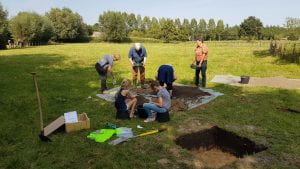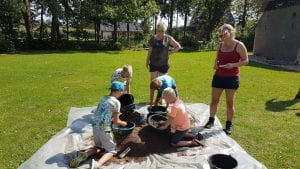 Fourteen test pits were excavated in Gemonde in August 2019 by more than 120 volunteers, organised by the local history club ‘Heemkundekring Den Hogert’. Finds processing was disrupted by the covid-19 pandemic, but initial findings from test pit 3 and 4 appear to confirm settlement on the coversand ridge in late prehistory. Pottery from test pit 4 indicates that the Roman villa site may have been occupied continuously up to as late as the seventh century.
Fourteen test pits were excavated in Gemonde in August 2019 by more than 120 volunteers, organised by the local history club ‘Heemkundekring Den Hogert’. Finds processing was disrupted by the covid-19 pandemic, but initial findings from test pit 3 and 4 appear to confirm settlement on the coversand ridge in late prehistory. Pottery from test pit 4 indicates that the Roman villa site may have been occupied continuously up to as late as the seventh century.
 Finds on the far side of the ridge suggest this area was occupied earlier than expected. Amongst the debris of the nineteenth century farm that stood here until the 1960s, several pieces of twelfth century Andenne pottery from the Belgian Meuse region were found in test pit 21. Combined with the characteristic rounded plot shape, this suggests that this was the site of an eleventh/twelfth century farm.
Finds on the far side of the ridge suggest this area was occupied earlier than expected. Amongst the debris of the nineteenth century farm that stood here until the 1960s, several pieces of twelfth century Andenne pottery from the Belgian Meuse region were found in test pit 21. Combined with the characteristic rounded plot shape, this suggests that this was the site of an eleventh/twelfth century farm.
 On the other side of Gemonde, on a farm on the edge of the former wilderness, finds from test pit 11 appear to confirm the relatively recent date of occupation here, with the earliest pottery dating to the eighteenth century, correlating neatly with the 1697 date found on a beam that discovered in the fireplace by the house owners during renovation work. So this farm seems to have been established during the reclamation of the wetland forest (carr) during this period.
On the other side of Gemonde, on a farm on the edge of the former wilderness, finds from test pit 11 appear to confirm the relatively recent date of occupation here, with the earliest pottery dating to the eighteenth century, correlating neatly with the 1697 date found on a beam that discovered in the fireplace by the house owners during renovation work. So this farm seems to have been established during the reclamation of the wetland forest (carr) during this period.
 On the south side of the Sint-Lambertusweg test pit 25 was dug on the site of a former farm of Our Lady’s Hospital of Boxtel. Although the farm was leased out by the nuns, we did find a later token of devotion from the tenant farmer: a beautiful tobacco pipe (1890-1920) brought back as a souvenir from Kevelaer, a seventeenth century pilgrimage site on the present Dutch-German border.
On the south side of the Sint-Lambertusweg test pit 25 was dug on the site of a former farm of Our Lady’s Hospital of Boxtel. Although the farm was leased out by the nuns, we did find a later token of devotion from the tenant farmer: a beautiful tobacco pipe (1890-1920) brought back as a souvenir from Kevelaer, a seventeenth century pilgrimage site on the present Dutch-German border.
